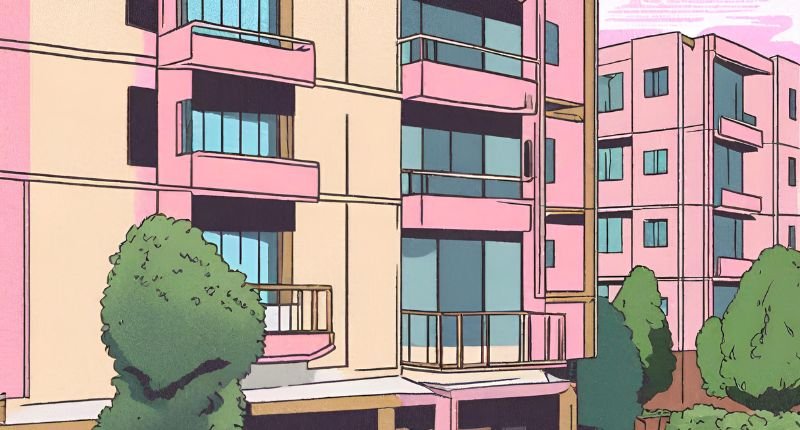- Perth’s affordability crisis and rental shortage are fueling demand for strata properties.
- Units offer lower entry prices but higher ongoing costs like strata fees.
- Units are an affordable investment and stepping stone into property ownership.
Strata properties are flying off the shelves in Perth.
Several reasons underlie this phenomenon. First, an affordability crisis has gripped the capital city, placing houses beyond reach for average Australians on average incomes.
According to SQM research, the capital’s weekly asking property price at the time of writing is a staggering $968,028. Units, on the other hand, are going for nearly half of that, at $507,779.
Perth weekly asking property price
Second, there is a severe shortage of rentals in Perth. Rental vacancy rates have plummeted to nearly 0.4%. The dearth of available rentals, combined with the robust demand for housing, has seen rents soar in tandem with this fall.
Perth rental vacancy
As the state’s rental market flounders at critical levels, many are looking to escape the rent trap—an option only made possible by the relative affordability of strata properties.
Perth asking rents
Meanwhile, Perth’s unit’s impressive rental yields continue to attract the attention of investors, both in and out of state, eager to capitalise on the comparatively lower unit prices and secure a foothold in the lucrative market.
Perth rental yields
Nevertheless, the notion of owning a unit has struggled to gain acceptance in Australia, where the Australian dream is synonymous with a four-by-two house.
Strata properties have also garnered a bad reputation owing to predatory strata management companies charging exorbitant fees and the lack of consumer protections should one receive a substandard product.
In addition, units generally see lacklustre capital gains when compared to their landed counterparts.
For this article, we consulted two of Perth’s top property experts, who demystified units as investments.
What are strata properties?
Resolve Property Solutions buyer’s agent, Peter Gavalas, explained that strata properties range from anything between two properties on one parent title to as many as hundreds of properties in a high-rise apartment complex.

“As in investment, a complex with high strata fees will reduce the return on the investment and possibly be harder to sell in future,” Gavalas said.
Larger complexes with more facilities, like pools and gyms, attract higher strata fees to pay for the operational cost of said facilities and the upkeep and maintenance of the buildings and infrastructure.
“It’s important, however, that any strata property is managed and maintained to a high standard, as this will always attract more owner occupiers and make it easier to sell if you need to do so.
“Non-strata or a house, the only costs associated are water, council rates and insurance. General maintenance and upkeep of the property need to be undertaken separately.”
Cygnet West manager of valuation, research, and advisory Justin Caldwell noted that the key selling points of units are the sense of community and perceived safety they provide.
“Units have a differing neighbourhood environment in that they have the bonus of a sense of community, but this may also come at the price or risk of close proximity disharmony,” he said.
“An advantage of units is the ability to lock and leave, whereas houses, to a certain extent, depend on neighbourhood watch.
“Some argue units have ‘low maintenance low care’ vs a busy neighbourhood house and curtilage land, which is true but comes at a cost. In units, strata undertake the care and maintenance, whereas at home, it is DIY.”
Houses vs Units: The cost of keeping a strata property
Indeed, Caldwell opined that while strata levies are more expensive compared to the cost of upkeeping residential homes, they do not draw the same maintenance fees for gardens, gutters, and land fees.
“Houses are unincumbered by strata fees, Council of Owner’s meetings and, most significantly, restrictions around renovations and/or value add improvements. Further, subject to the building envelope and lot size, houses allow for future expansion i.e. additional bedrooms or extend garage,” Caldwell said.
“In contrast, units have the advantage of somewhat predictable maintenance fees and are generally more affordable to purchase. Apartments have the additional benefit of security (both technology and the comfort of knowing many other neighbours are close by) and additional communal facilities such as a gym and rooftop entertainment.”
However, Caldwell pointed out that these amenities come with a hefty price tag, demanding fees for servicing their operational costs, as well as lifecycle replacement costs.
Units also have less flexibility and independence. Subject to council approval and neighbour consent, investors are constricted to internal renovations and improvements,
Another reason houses hold the edge over units is that they comprise a land component, a rarity in the inner city and suburbs.
“Units on the other hand, while providing exposure to the rising property market, can traditionally be supplied with relative ease meaning that,” Caldwell said.
“For example, this year there might be 300 apartments in any given suburb, and in two years there may be 500 – the additional supply will invariably slow capital growth, particularly in established and/or inferior product.”
Investment performance of units
Although single-detached housing has historically outpaced apartments as investments, Caldwell predicts this may change due to the housing supply crisis.
“At a low-rise, no-amenity complex (including group/townhouse) where the product line has higher market acceptance and, broadly speaking, an operating cost similar to a house, it’s reasonable that we may see the same performance measure observed with single detached housing,” he said.
“Units as investments, particularly established units (greater than three years old), provide exposure to the market with considerably less onerous purchase prices, when comparing at the average. This is the overwhelming positive attribute and what is supporting the demand we are seeing for them.
“Financially, access to an investment unit is less restrictive. Recent growth has increased the popularity of units/strata properties, and we expect to see this continue in line with the Perth population.”
Gavalas expressed similar sentiments to Caldwell, noting that units can be good investments, provided they are not high-density.
“Units can be a good investment provided they are in a smaller complex, have relatively low strata fees and are in an inner city suburb.
“These will generally have an underlying land content for each unit along with some land value.
“Newer units in larger complexes have no underlying land value, and like buying a new car, they will diminish in value as they age. Over the past 20 years, houses have outperformed units by 46% more growth.”
“The significant growth in median Perth rents has gained attention from local and eastern state investors looking for a stronger yield at a lower entry price.”
Justin Caldwell, Cygnet West
“From December 2020 to December 2023, the median unit price has grown 12.7% compared to the median house price growth of 32.4%,” Caldwell said.
“While unit prices have grown at a slower rate, in the same period, median rent has grown 53.4% for units and a slightly lesser 48.8% for houses.
“Considering the affordability of units compared to houses, as well as their relative capital growth, they are appealing to a wide variety of buyers for both accommodation and as an investment.”
“Lack of supply is contributing to such dramatic growth in capital values and rents. There are not enough resources for developers to complete new apartment projects in the short to medium-term outlook. There is insufficient labour to complete new projects without volatility or construction delays.”
“Cygnet West anticipates continued strong demand for units in Perth, due to housing shortages and ongoing population growth stemming mostly from Net Overseas Migration.”
What is being bought?
Caldwell listed the market preferences in order of preference as follows:
- Single-detached house
- Group house
- Villa house
- Town House
- Terrace
- Apartments and units
Moreover, he confirmed that rental pressures have been driving people into homeownership.
“As the cost of renting continues to approach, and in some suburbs has overtaken, the cost of a mortgage, we are seeing a trend towards people buying units to live in rather than continuing to rent.
“The majority of this buying activity is in the outer suburbs, which is evidenced by the strong growth they are experiencing, as seen in CoreLogic’s Hedonic Housing Index, where the top 10 growth locations by suburb are in the outer suburbs of Perth.”
A lot more buyers, investors and owner occupiers are turning to strata properties due to affordability, low maintenance and proximity to the city,” Gavalas observed.
“As house prices are moving up, more buyers are considering strata properties rather than buying houses in distant suburbs or lower socio-economic areas.”
Who is driving unit-buying activity?
Boasting profitable yields, lower prices, and often situated near public transport and amenities, Gavalas said units were growing popular among all types of buyers, from first-home buyers and investors to downsizers.
“Given the lower price point barrier and location, units have seen more activity from the first-home buyers, especially in inner-city suburbs,” Gavalas said.
“Middle-ring suburbs close to public transport can provide some great buying, especially given the replacement cost of units has gone up considerably over the past four years.”
Peter Gavalas, Resolve Property Solutions
On the other hand, Caldwell speculated that investors from the east were driving much of Perth’s unit-buying activity.
“Based on real estate agent advice, anecdotally there is presently greater observed activity from east coast investors across all residential product lines, with a common theme being expressed being price point difference west to east.
“First homeowner activity in apartments is reportedly weak. The apartment owner-occupier market is being fuelled by downsizers.
“The Monthly WA Housing Finance Approvals data released by the ABS show Investor Finance approvals for new and established dwellings accounted for 37% of approvals in January 2024. This number is consistent with the industry feedback from experts and agents about the proportion of eastern state buyers who are also investors.
“First homeowners accounted for 23% of Housing Finance Approvals in January 2024.”
Units as a stepping stone into the property game
Both experts agreed that units are an excellent entry point into the property market, particularly for buyers with affordability concerns.
“Buying a unit in a smaller complex is a great stepping stone to buying a house, especially if you are limited by borrowing capacity and budget,” Gavalas said.
“This also provides an option to add value through renovations. Given units are generally smaller properties, a smaller budget can go a long way with updating flooring, kitchens, bathrooms and painting.
“Most buyers prefer to buy renovated or newer properties. Through renovation, first-time home buyers are able to increase the value of their property fairly quickly.”
“At this juncture, there are few affordable options in the market for first homeowners, given the majority of activity is in wealthier suburbs,” Caldwell concurred.
“Great idea, but not met practically on the ground. The activity will instead be noted in the middle ring and more likely in a group house/villa house and small unit complex.
“Buying a unit instead of a house would allow an individual to address their own accommodation needs for a relatively cheaper cost and expose themselves to potential short-term capital growth in the property market.
“We are predominantly seeing first-time home buyers’ purchasing decisions dictated by proximity to family, work or study, and amenities. Buying a unit, particularly a cheaper established unit, would potentially give them the proximity they desire and allow them exposure to some short-term capital growth.”





